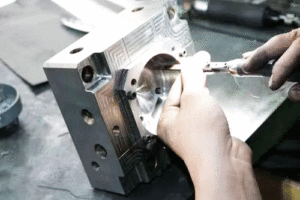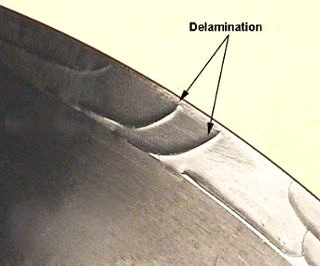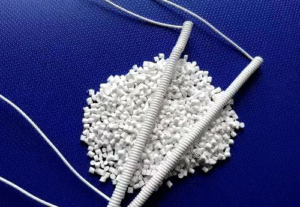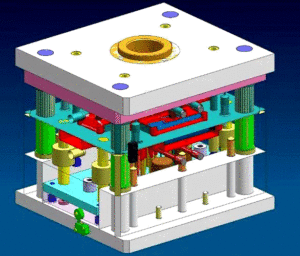
Polishing Treatment for Plastic Molds
Polishing Treatment for Plastic Molds With the widespread application of plastic products, such as daily-use items and beverage packaging containers, there is often a requirement
In last part, we introduced the causes and solutions of some problems in injection molding. Today we will continue to introduce causes and solutions of problems like delamination, streamlines, grooves, various streaks, stresses and whitening.
Delamination, sometimes called layering, with the surface of a molded part peeling off layer by layer. It’s generally considered a fairly serious defect as it reduces the strength of the assembly.
The most common cause of delamination is contamination of resin particles or other substrates with foreign matter. Sheet separation occurs when two materials are not properly bonded. For example, combine common base plastics such as acrylonitrile butadiene styrene (ABS) with incompatible plastics such as polypropylene (PP).

Streamlines appear as a wavy pattern, usually slightly different from the color of surrounding area. Besides, it’s usually on a narrower portion of the molded component.
They may also appear as annular bands on the product surface near the mold entry point, or “gates” through which molten material flows. Flow marks generally do not affect the integrity of the assembly. However, if they are found in certain products, such as high-end sunglasses, they can be ugly and unacceptable.

Streamlines are generally the result of changes in the cooling rate of the material. Because it flows in different directions throughout the mold.
Differences in wall thickness can also cause the material to cool at different rates, leaving streamlines. For example, molten plastic cools very quickly during injection, and flow marks are evident when the injection speed is too slow. While still filling the mold, the plastic becomes partially solid and sticky, causing the ripples to appear.
A groove is a surface defect in which “rings” appear on the surface of the molded part, mainly near the pin point gate and spread concentrically onto the molded part.

Air streaks in molded parts appear as matt, silver or white streaks (stripes) on the surface of the molded part. They can often be found in domes, ribs, and where the wall thickness of molded parts may vary. What’s more, they can also appear near gates or near engravings and depressions.

Wet streaks may appear on the surface of the molded part because the U-shaped profile opens against the flow direction. They usually appear as silver streaks with a rough or porous surface. Wet streaks caused by moisture on the mold surface appear as large and matt lamellar structures.

The main reason is the condensation of moisture in the resin and that on the mold surface.
Reduce moisture content in resin.
Color streaks may appear on colored parts due to uneven distribution of color pigments in the product or different orientations of isotropic pigments in molded products.
Thermal effects (pigment degradation) can also cause different shades of color to appear on items.

Stress whitening is caused by stress cracking in polymeric materials due to internal and external stress. In PP, stress whitening usually occurs with the copolymer as the microcracks between matrix and rubber phase. A typical appearance location is the demold point. Stress cracks caused by internal stresses can often appear days or even weeks after the production of the relaxation process of the molded part.

Gloss differences typically arise due to wall thickness differences in the molded part and subsequent different cooling rates in different areas.

Molded parts may stick in the mold and not pop out properly. This usually occurs when the level of shrinkage is too low or too high to spray easily. Or when the shape and surface finish of the molded article creates a “stick” effect in the mold itself.
It should be noted that the problems in the injection molding process and their solutions are not unique. They are also affected by machine usage, machine setup, mold type and complexity, materials, and manufacturing environment.
Typically, injection molding manufacturing requires a large up-front investment in molds. Therefore, the first mold design is especially important. And we should try to avoid redesigning after serious defects are found. In contrast, defects related to the molding process or materials are often easier and less expensive to resolve. But whatever the cause, defects in molded products can greatly limit the production of molded devices. The above 18 common injection molding defect problems and solutions will be helpful to the smooth and qualified production of injection molding products.

Polishing Treatment for Plastic Molds With the widespread application of plastic products, such as daily-use items and beverage packaging containers, there is often a requirement

Injection Molding Techniques for TPE and TPR Injection Molding Techniques for TPE and TPR 1. Dry the TPE and TPR material before injection molding It

Winter Maintenance Measures for Injection Molding Machines As winter approaches and temperatures gradually drop, a cold chill envelops the earth. While ensuring personal warmth, it

Assessment Regulations for Mold Trial Exceeding 3 Times Assessment Regulations for Mold Trial 1. Purpose The purpose of this regulation is to standardize the work of